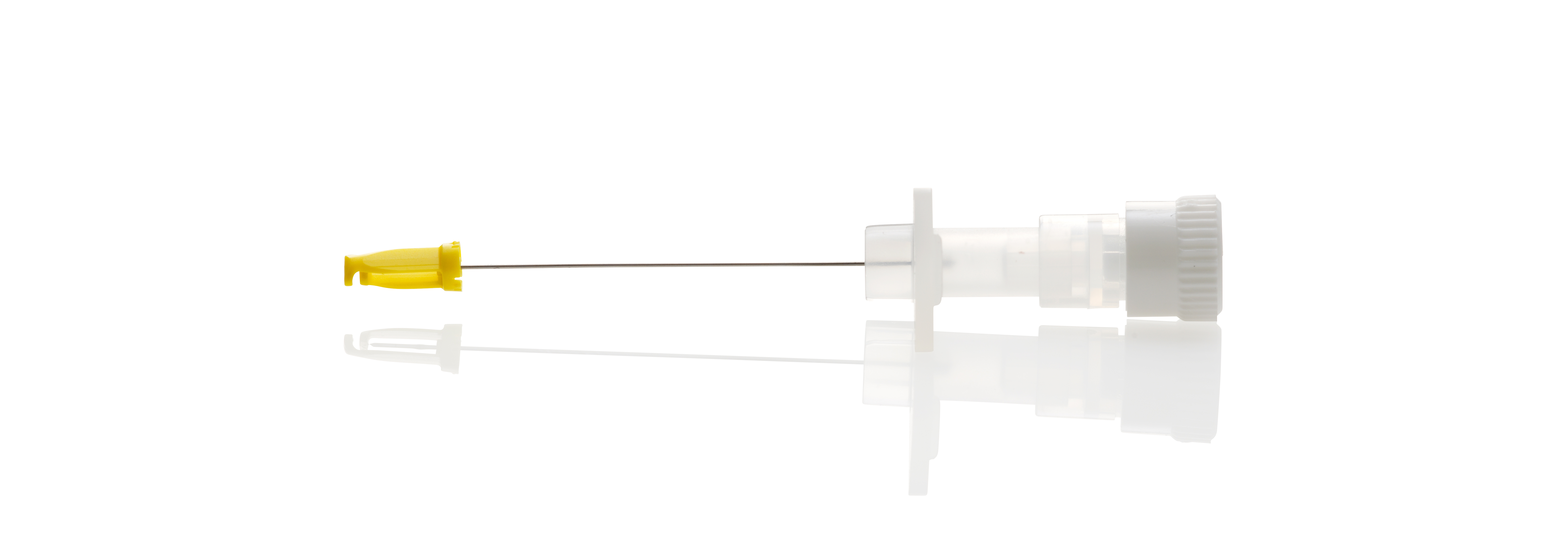The challenges of pediatric IV cannulation

Although Petra Langmayr doesn’t have direct contact with young patients anymore, her passion for helping children is always there. To help provide the best possible working environment in the hospitals – one where the children's safety and health always come first. Read about experiences and insights of the work as a pediatric nurse: the daily challenges, the importance of safety and why every hospital should be using safety IV catheters.
Tell us a little bit about yourself and your background
- I'm a pediatric nurse, since almost 28 years, so I’ve worked with children from age 0 to 18. This is what we have in Austria, when you work in a children's hospital and children's departments you have children who are age zero, even premature born and up to 18. I worked as a pediatric nurse until 2016. And then I came to Greiner Bio-One (GBO) as a sales representative.
Was becoming a nurse a dream of yours from when you were young?
- Yes, I always wanted to be a pediatric nurse. Even when I was in preschool, I said: I don't want to have a job I want to work with children. It's really something from the heart.
What made you change your career?
- I was a management nurse for 15 years which meant I managed 50 nurses. It was getting more and more difficult during the years. And I finally understood that I wasn’t at terms with the healthcare institution anymore, so I decided to move on. I could still work as a nurse if the focus was more on the patients and the people. But now at GBO I have the advantage of my experience, I can talk to people in healthcare institutions differently because of my background.
What would you say is the most rewarding about working with children?
- I like children. I think it's necessary to make it work. They are so open-minded, and so much fun. When they understand that you care about them and want to help them, they are very open and grateful for the attention. Also, the situation they are in, being in a hospital, can be dominated by pain and fear. But when you help them, you get so much back emotionally. So, I really do miss the children. And the parents of course.
"The daily challenge is that you never know what kind of patients you will meet. There's a lot of fear in the air. You must be very empathetic and at the same time organize what is needed."
What daily challenges did you face during these 28 years of working as a nurse?
- The daily challenge is that you never know what kind of patients you will meet. It can be ranging from patients having a small surgical procedure or a major operation. And you never know the outcome, which is very challenging when it comes to children. You always have parents or relatives who accompany them, and you must cope with them too. There's a lot of fear in the air. You have to be very empathetic and at the same time organize what is needed. When you’re in the ward, one of the daily tasks is to insert IV catheters, which is always fearful for the patients, especially for the small ones. Other procedures can be painful too, like giving a colonic irrigation or changing wound pads. So, you must talk to the patients a lot and try to create a safe space.
How do you do that practically, make them feel safer?
- Talking, being self-confident and not lying to them. Some parents tell their kids that they are going to the hospital to play. A kid like that won’t be ready for insertion of an IV catheter or other painful procedures. So, it’s important to prevent fear in the beginning.
How about the parents?
- You have to assure them that you are trying to help their child. This is what I want to convey to the parents. I will help them and try to minimize the pain. It helps if you are self-confident. No matter what happens, you can cope with it and transfer this emotion to the parents. Then they trust you. You only do what is necessary to help their child.
"Some nurses are very talented when it comes to performing venipuncture. You always have to check which site is most suitable for the puncture. The staff are getting better at locating suitable veins - the education is better now. The products are better as well."
Have you had any extra tricky situations when it comes to placing an IV catheter?
- An IV catheter is something you have to place on almost every child in the ward. It’s always stressful when it comes to small children, you never know if the first insertion attempt will be successful. Small children have fragile veins that are very difficult to puncture. And these children are often suffering from long-term illnesses and might have been in the hospital for months. There is always an anesthetist in the background when it comes to small children, so as a nurse you try maximum two times then you ask the doctor to take over.
What would you tell a child who is very afraid of needles?
- I would say that it might hurt a bit for a short time, but we have something to prevent it, like an anaesthetic cream. We use an anaesthetic cream that you put on the insertion site half an hour before you do the venipuncture. Then the insertion site becomes numb, which is very good. Of course, it's very challenging because no child wants to be hurt or feel pain.
Has it become more or less challenging to handle these situations?
- Some nurses are very talented when it comes to performing venipuncture. You always have to check which site is most suitable for the puncture. Sometimes a puncture in one of the veins in the head is required since it’s much easier to find a vein there. However, most parents don't like it, so we don't do it as often as we did 20 years ago. Also, the staff are getting better at locating suitable veins - the education is better now. The products are better as well.
Like CLiP® Neo?
- Yes, CLiP® Neo is a good example. I’m totally convinced that CLiP® Neo is the best IV catheter for children these days. So, I’m happy that I can offer it to the wards.
What would you say is the most common cause of a small child needing treatment and requiring an IV catheter?
- The most common thing is that they don't drink, or they have diarrhea, they are losing fluid and need to replenish that. Many need it because they are going through operations, sometimes big operations where you have to withdraw blood for analysis. And it is of course used to provide nutrients or blood.
How many of these IV catheters are also designed to protect the safety of the nurses?
- In Austria we have to use safety products according to regulations because of needlestick injuries. There are doctors who often believe it is easier to perform the venipuncture and place an IV catheter without a safety mechanism. I have customers that use CLiP® Neo and many of them are very open-minded. They want to have the safety mechanism. They have this mindset of safety first. When it comes to adult patients safety products are often used.
Have you ever suffered a needle stick injury?
- No, never. In general, there are fewer needlestick injuries nowadays because we use safety products. Especially us nurses. We are very aware of the risks and the problems that might occur. But if it happens there is a protocol that is followed.
How would you describe an automatic safety IV catheter to someone who's not familiar with it, what role is it playing in the healthcare setting?
- Since you have to withdraw blood or insert a catheter there is always a needle that needs to be inserted. This needle should be very sharp and that also poses the greatest risk of getting injured. So, a safety mechanism was created. When you remove the needle, the catheter stays in the vein. And when the needle comes out of the catheter it’s never exposed, it is covered by a safety clip thereby protecting you from contact with the needle. So yeah, you can’t get hurt. Which is very good.
What would you say are the major advantages of CLiP® Neo from a nurse's perspective?
- It’s absolutely the sharp needle and the instant blood response. Because of the small notch in the needle, you can easily see if you're in the vein. This is a very big advantage. Some catheters glide when you try to insert them in a vein, it’s not really going in because the vein is rolling. But with CLiP® Neo, you put the catheter in the vein and it’s in, it usually works well the first time. So that's a major advantage. And of course, the safety mechanism as well. It is useful especially when it comes to the small children in my opinion. Since you very often don't think about the needle, you put it on the table and then the needle tip is covered. You don't have to be afraid of any accident happening.

Although safety IV catheters have major advantages some hospitals don’t use them. The cost doesn’t seem to be the biggest obstacle, it is more related to attitude and ways of working. However, nurses can play an important role in convincing the doctors or decision makers to start using certain products.
If you were to advise a nurse that will convince his or her boss to start using CLiP® Neo, what would you say?
- I would first say that I'm a pediatric nurse myself. I would tell them that the needle is very sharp, and the blood response is instant, which helps you to get it right the first time. This is a big advantage even if you're not so experienced in performing a venipuncture. You just glide into the vein and it is not rolling and rolling. I would also say that we have an automatic safety mechanism that doesn't require an additional action by the user to activate. The safety clip is very small and light weight and does not affect the insertion.
CLiP® Neo also has a strength in the fact that blood sampling is included as indication for use. It is very common to use IV catheters for blood sampling anyway, but as regulatory directives get more and more important it is a significant strength to have it included in the Instructions for Use (IFU). This is an advantage for the health care facilities but also for the patients – being able to perform two necessary procedures with only one venipuncture minimizes pain and discomfort.
What would say is the best with your job?
- For me is the interaction with the customers. Advocating products like CLiP® Neo. Being able to offer this useful and good product is so much fun. I don’t work as a nurse anymore, but I can provide things that make a tough situation a little less tough for the children.
For more information about CLiP® Neo visit this page or contact your local distributor.